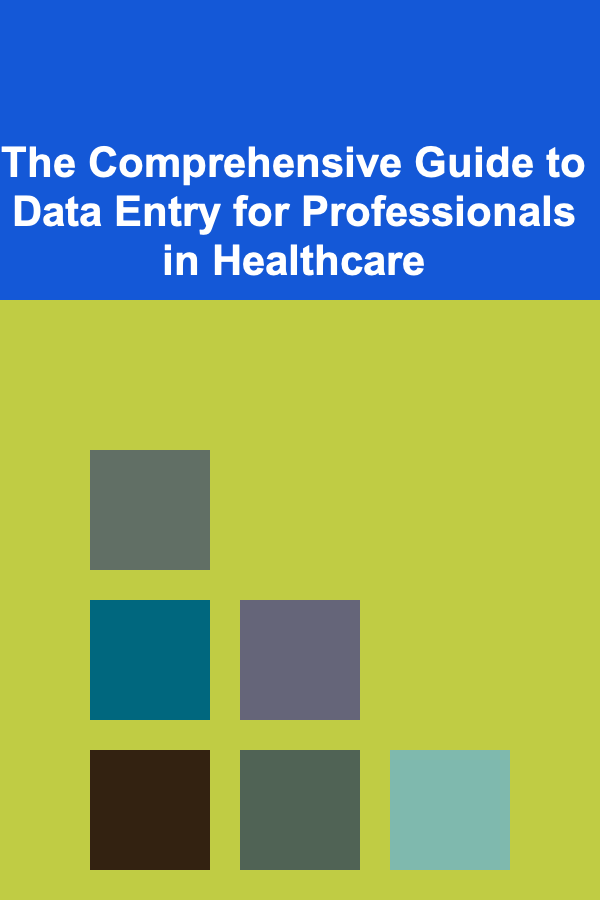
The Comprehensive Guide to Data Entry for Professionals in Healthcare
ebook include PDF & Audio bundle (Micro Guide)
$12.99$6.99
Limited Time Offer! Order within the next:

In the healthcare industry, data entry is a critical function that supports the management of patient information, clinical data, administrative tasks, and more. Accurate and efficient data entry ensures that healthcare professionals can provide the best care possible to patients, while maintaining compliance with regulations and optimizing operational processes.
This guide will walk you through the various aspects of data entry in healthcare, including its importance, best practices, common challenges, tools, and tips to streamline workflows while maintaining the highest levels of data integrity and security.
Understanding the Importance of Data Entry in Healthcare
Data entry in healthcare goes beyond just typing or entering information into a system. It plays an integral role in every part of healthcare, from patient care and treatment to administrative management. The importance of accurate data entry cannot be overstated, as it directly impacts:
1. Patient Care and Safety
Healthcare data entry involves managing detailed patient records, including medical histories, medications, lab results, and other vital information. Accurate entry ensures that clinicians have up-to-date data to make informed decisions, thus improving patient safety and outcomes.
2. Regulatory Compliance
Healthcare is one of the most regulated industries in the world. Proper data entry is crucial for meeting legal and regulatory requirements, including the Health Insurance Portability and Accountability Act (HIPAA) in the U.S. and GDPR in Europe. Any errors in data entry could result in costly fines or legal complications for healthcare providers.
3. Operational Efficiency
Effective data entry can optimize operations within healthcare facilities. By minimizing errors and duplication of efforts, healthcare organizations can streamline processes such as appointment scheduling, insurance processing, and billing, leading to more efficient and cost-effective operations.
4. Research and Analytics
Data entry also supports medical research and the development of healthcare policies. Accurate data helps researchers analyze trends in patient care, treatment outcomes, and disease prevention. The insights gathered can lead to improvements in healthcare services and drive evidence-based practices.
Key Elements of Data Entry in Healthcare
Healthcare data entry is a multifaceted task that requires attention to detail and adherence to specific standards. Let's explore the key elements involved:
1. Patient Information
The most important aspect of healthcare data entry involves managing patient records. These include personal details like name, date of birth, contact information, and insurance details, as well as medical history, diagnoses, treatment plans, and progress notes.
2. Electronic Health Records (EHR)
EHR systems have revolutionized data entry in healthcare by digitizing patient records. Data entry professionals must input and maintain data within EHR systems accurately to ensure that the system functions correctly and reflects the patient's current status.
3. Clinical Data
Clinical data includes information such as test results, vital signs, prescriptions, lab reports, and imaging data. Accurate entry of clinical data is crucial for effective decision-making in diagnosis and treatment planning.
4. Billing and Coding
Healthcare data entry professionals also play a vital role in entering billing codes, such as ICD-10 codes for diagnoses and CPT codes for procedures. Accurate coding ensures that providers are reimbursed appropriately by insurance companies and helps maintain compliance with insurance policies and government regulations.
5. Appointments and Scheduling
Data entry in healthcare also includes managing patient appointments, including scheduling, cancellations, and follow-ups. A well-maintained scheduling system helps reduce wait times, ensures proper allocation of resources, and enhances the overall patient experience.
Best Practices for Effective Data Entry in Healthcare
To ensure accuracy, efficiency, and compliance, healthcare professionals must follow best practices in data entry. Below are key practices to keep in mind:
1. Accuracy and Attention to Detail
Accuracy is paramount in healthcare data entry. Small mistakes---such as typos in patient names, incorrect medication doses, or wrong billing codes---can have severe consequences. Professionals should verify the data they enter and double-check for errors before submission.
2. Standardization of Data
Data must be entered in a standardized format to ensure consistency across records. This includes consistent terminology, date formats, and address formatting. Standardization not only makes data entry easier but also helps improve the quality and reliability of data.
3. Data Security and Confidentiality
Confidentiality is critical in healthcare, and data entry professionals must follow strict security protocols to protect patient information. This includes using secure systems and networks, following password policies, and abiding by regulations such as HIPAA.
4. Regular Training
Given the rapid changes in healthcare technology and regulatory standards, data entry professionals must undergo continuous training. Training should cover the latest software updates, coding systems, legal requirements, and best practices to maintain high standards of data accuracy and security.
5. Use of Templates and Predefined Fields
Many EHR systems offer templates and predefined fields to help streamline data entry. By utilizing these features, professionals can reduce the risk of error, speed up the process, and maintain consistency across records.
6. Automating Data Entry Where Possible
Automation tools can significantly reduce the workload for healthcare data entry professionals. Using optical character recognition (OCR), voice recognition, and artificial intelligence (AI) systems to automate certain data entry tasks can improve efficiency and accuracy, while freeing up time for more complex tasks.
Challenges in Healthcare Data Entry
While data entry plays a critical role in the healthcare sector, there are several challenges that professionals must navigate:
1. Volume of Data
The sheer volume of data that needs to be entered can be overwhelming. Healthcare facilities generate massive amounts of data daily, from patient records to administrative documents. Handling this data requires speed, accuracy, and organization.
2. Inconsistent Data Formats
Healthcare data is often fragmented and stored in different formats across various systems. This inconsistency can make it difficult to enter, retrieve, or analyze data. Standardizing data formats across different platforms and ensuring seamless integration of systems is a challenge for many healthcare providers.
3. Data Entry Errors
Human errors in data entry are inevitable. Mistakes such as typographical errors, incorrect coding, or failure to enter critical data can jeopardize patient safety, billing accuracy, and regulatory compliance. Implementing robust quality assurance processes can help minimize these errors.
4. Data Integration
Data is often stored in multiple systems, such as hospital management systems, EHR platforms, and laboratory information systems. Ensuring that all data systems are interoperable and that information flows seamlessly between them is a significant challenge for healthcare providers.
5. Security Concerns
Healthcare data is a prime target for cybercriminals due to its sensitive nature. Protecting data from breaches requires constant vigilance and the implementation of comprehensive cybersecurity measures.
Tools and Technologies for Data Entry in Healthcare
Several tools and technologies are used to support healthcare data entry professionals in their work. These include:
1. Electronic Health Records (EHR) Systems
EHR systems are the backbone of healthcare data entry. Popular systems include Epic, Cerner, and Allscripts. These platforms enable healthcare providers to enter, update, and manage patient records digitally, improving both efficiency and data accuracy.
2. Practice Management Software
Practice management software helps healthcare professionals manage appointments, billing, coding, and patient communications. Popular platforms include Athenahealth and NextGen Healthcare.
3. Speech Recognition Software
Speech recognition software allows healthcare professionals to dictate patient information, notes, and medical histories instead of typing. This technology can help improve the speed of data entry while reducing the physical strain of typing.
4. Optical Character Recognition (OCR)
OCR technology can automatically scan and extract data from handwritten or printed documents. This reduces the time spent manually entering information and increases accuracy, especially in cases where paper records are still in use.
5. Artificial Intelligence (AI) and Machine Learning (ML)
AI and machine learning are increasingly being used to automate data entry and improve accuracy. For instance, AI can analyze medical images, extract relevant data, and input it directly into EHR systems, reducing the need for manual entry.
Tips for Improving Data Entry Efficiency
Healthcare professionals can adopt various strategies to improve the efficiency of data entry while ensuring quality and accuracy:
1. Keyboard Shortcuts
Many EHR systems allow the use of keyboard shortcuts to speed up data entry. Learning these shortcuts can save valuable time, especially for tasks that are frequently performed.
2. Data Validation Tools
Using data validation tools can help catch errors before they become problems. For example, validation tools can ensure that dates, phone numbers, and medical codes are entered in the correct format.
3. Reducing Paper Documentation
Whenever possible, shift from paper-based data entry to digital systems. This minimizes the risk of transcription errors and enhances the overall efficiency of the process.
4. Regular Audits and Quality Control
Establish regular audits and quality control processes to identify any discrepancies or errors in entered data. Continuous quality checks help maintain the integrity of the data and ensure that errors are corrected promptly.
Conclusion
Data entry is a foundational element of healthcare that directly impacts patient care, safety, and operational efficiency. By adopting best practices, leveraging the latest tools and technologies, and staying vigilant about security and accuracy, healthcare professionals can ensure that data entry supports a seamless and high-quality healthcare experience.
Despite the challenges, the evolving landscape of healthcare technology continues to provide solutions that simplify and optimize data entry processes. By embracing these advancements and focusing on continuous improvement, healthcare providers can enhance both their operational processes and the quality of care they offer to their patients.

How to Clean Your Home in 30 Minutes a Day
Read More
How to Create a Checklist for Booking Vacation Activities and Tours
Read More
How to Make Your Bathroom Festive for the Holidays
Read More
The Future of Work: Skills to Prepare for Tomorrow's Job Market
Read More
How to Play Trivia Board Games: A Comprehensive Guide
Read More
How to Aquascape a Dutch Style Aquarium: A Detailed Guide
Read MoreOther Products

How to Clean Your Home in 30 Minutes a Day
Read More
How to Create a Checklist for Booking Vacation Activities and Tours
Read More
How to Make Your Bathroom Festive for the Holidays
Read More
The Future of Work: Skills to Prepare for Tomorrow's Job Market
Read More
How to Play Trivia Board Games: A Comprehensive Guide
Read More